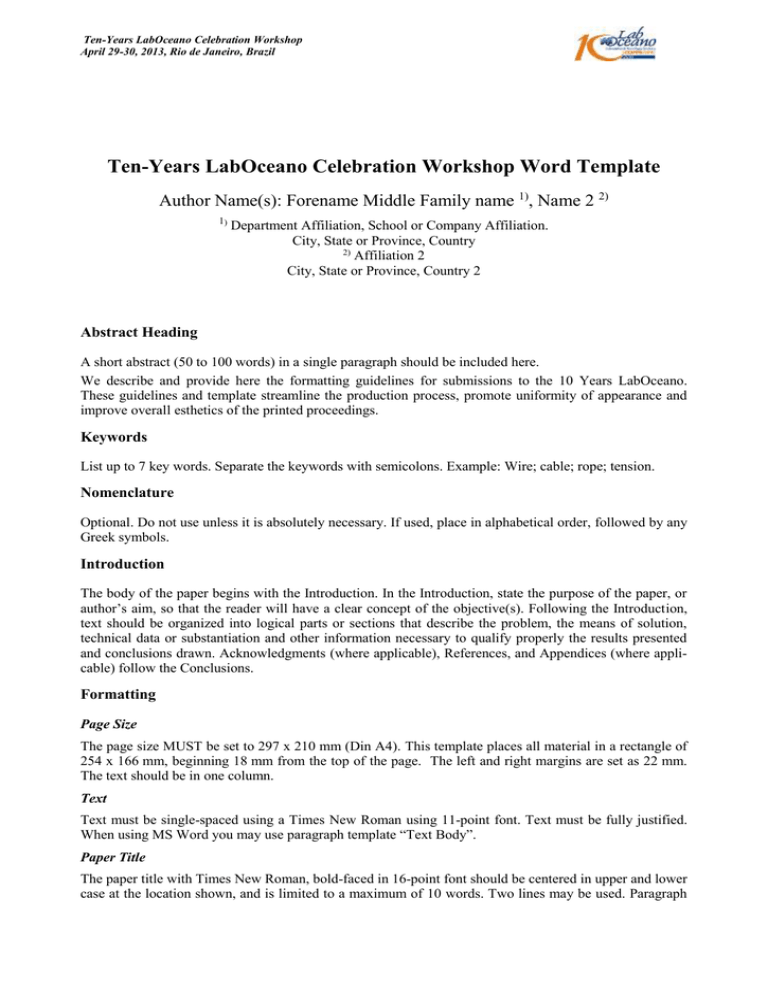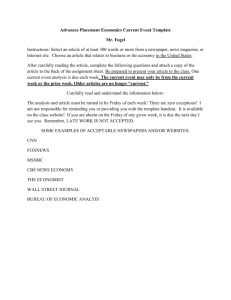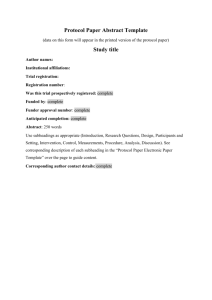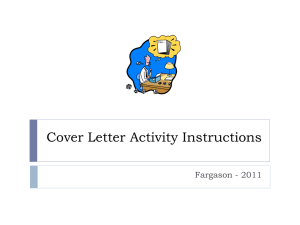PRADS 2004 Proceedings Word Template
advertisement

Ten-Years LabOceano Celebration Workshop April 29-30, 2013, Rio de Janeiro, Brazil Ten-Years LabOceano Celebration Workshop Word Template Author Name(s): Forename Middle Family name 1), Name 2 2) 1) Department Affiliation, School or Company Affiliation. City, State or Province, Country 2) Affiliation 2 City, State or Province, Country 2 Abstract Heading A short abstract (50 to 100 words) in a single paragraph should be included here. We describe and provide here the formatting guidelines for submissions to the 10 Years LabOceano. These guidelines and template streamline the production process, promote uniformity of appearance and improve overall esthetics of the printed proceedings. Keywords List up to 7 key words. Separate the keywords with semicolons. Example: Wire; cable; rope; tension. Nomenclature Optional. Do not use unless it is absolutely necessary. If used, place in alphabetical order, followed by any Greek symbols. Introduction The body of the paper begins with the Introduction. In the Introduction, state the purpose of the paper, or author’s aim, so that the reader will have a clear concept of the objective(s). Following the Introduction, text should be organized into logical parts or sections that describe the problem, the means of solution, technical data or substantiation and other information necessary to qualify properly the results presented and conclusions drawn. Acknowledgments (where applicable), References, and Appendices (where applicable) follow the Conclusions. Formatting Page Size The page size MUST be set to 297 x 210 mm (Din A4). This template places all material in a rectangle of 254 x 166 mm, beginning 18 mm from the top of the page. The left and right margins are set as 22 mm. The text should be in one column. Text Text must be single-spaced using a Times New Roman using 11-point font. Text must be fully justified. When using MS Word you may use paragraph template “Text Body”. Paper Title The paper title with Times New Roman, bold-faced in 16-point font should be centered in upper and lower case at the location shown, and is limited to a maximum of 10 words. Two lines may be used. Paragraph template: “Title” Author Name(s) Author names in 14 point font should consist of first name and middle name initials followed by the complete last name in upper and lower case, centered under the title. Paragraph template: “Author Name(s)” Affiliation(s) Use upper and lower case in 11 point as shown above. Do not include street address, postal code, email or fax numbers. Paragraph template: “Affiliation” Section and Subsection Heads Headings and subheadings appear throughout the text to divide the subject matter into logical parts and emphasize major elements and considerations. Do not number them. Section Heads should be flush left in all upper and lower case using 12-point bold font. Paragraph template: “Section Head” Subsection Heads should be bold-italic and flush left in upper and lower case using 11-point font. Paragraph template: “Subsection Head” For subsection heads, a word like “the” or “a” is not capitalized unless it is the first word of the header. Text Citation of References Within text of an article, references are to be cited by last name of author(s) and year of publication. Each reference to include last names of all authors. For example: .....was discovered (Smith, 1977) Smith and Miller (1990) proposed … Scott (1980a) discovered ..... It was also noted (Smith, 1980b; Scott, 1992) that ..... Length Paper should not exceed 20 template pages including illustrations. Tables It is often advantageous to place information in a tabular format as shown here. Number tables consecutively and use table numbers when referring to a table (Table 1, Tables 2~3,...). Table 1: Table captions should be placed above table, left-justified. Paragraph template: “Table Caption” *Use SI Units for all weights and measures. If other units are used, the equivalent SI Unit should be included as shown above. Equations Equations are to be numbered consecutively from Eq. 1 to the end of the paper including any appendices. Use the equation number when referring to equations (Eq. 1, Eqs. 5~7,...). Please take care to type equations accurately. Equations should be 10-point and should be as centered as possible. Enclose equation numbers in parentheses and place flush right with right-hand margin. Paragraph template: “Equation” F( x, y, z; t ) A x x 2 B y y 3 Cz exp k x x t (1) Figures Number figures consecutively and uses the figure number when referring to a figure (Fig. 1) or figures (Figs. 2~3). Figures must have a caption consisting of an abbreviated number, like Fig. 1, and brief title and should be placed below figure, centered. Paragraph template: “Figure Caption” Place figures/images in a paragraph centered. Paragraph template: “Figure” Fig. 1: Figure brief title For good legibility, lines, letters and symbols must be of sufficient darkness, size and thickness. Avoid using shades. Place figures/images in text as close to the reference as possible. Please be aware of the quality of your figures, illustrations, and photos. Figures that are line-art should be scanned at 1200 dpi, whereas screened figures and photos should be scanned as grayscale at 600 dpi. Avoid high JPEG-compression for PDF making. Footnotes Optional, but do not use unless it is absolutely necessary1. Footnotes should be 10-point and justified to the full width. Conclusions A brief summary of your research results should be included in this section toward the end of the paper. Acknowledgement Acknowledgements may be made to those individuals or institutions not mentioned elsewhere in the paper that made an important contribution. References References to original (not secondary) sources for cited material is to be listed together at the end of the paper and should be justified ragged right. References should be published materials (excluding computer program manuals) accessible to the public. Internal technical reports may be cited only if they are easily accessible to the public or any reader. Private communications should be acknowledged within text, not referenced (e.g., “[Smith, personal communication]”). List of References shall be arranged in alphabetical order of last name of first-named author for articles with more than one author. Do not number them. Paragraph template: “Reference” Examples are: Aubault, A, Yeung, R.W. (2012), “Interference Resistance of Multi-hull Vessels in Finite-Depth Waters,” Proceedings of the International Conference of Offshore Mechanics, and Arctic Engineering (OMAE), Rio de Janeiro, Brazil. Chakrabarti, S. K. (1994). Offshore Structure Modeling, World Scientific, Singapore. Gopalkrishnan, R. (1993). “Vortex Induced Forces on Oscillating Bluff Cylinders,” Ph.D. thesis, MIT, Cambridge, MA. Hallermeier, R.J. (1976). "Nonlinear Flow of Wave Crests Past a Thin Pile," Journal of the Waterways, Harbors and Coastal Engineering Division, Vol 102, No 4, pp 365–377. Longuet-Higgins, M.S., and Fox, M.J.H. (1977). "Theory of the Almost Highest Wave: the Inner Solution," Journal of Fluid Mechanics, Vol 80, pp 721-41. Newman, J.N. (1978). Marine Hydrodynamics. MIT Press, Cambridge. Smith, D.E. (1992). "Dynamics of Ice Cover Interacting with Ocean and Atmosphere," International Journal of Offshore and Polar Engineering, Vol 3, No 1, pp 43-50. Sparrow, E.M. (1980a). "Parallel Processing ...," Sparrow, E.M. (1980b). "Forced-Convection Heat Transfer ... Protuberances," Numerical Heat Transfer, Vol 12, No 2, pp 149-167. Appendixes In a highly mathematical paper it is advisable to develop equations and formulas in an appendix. Appendixes also may be used for detailed descriptions of apparatus and other related material not essential to general presentation of subject. 1 Footnote Manuscripts for Review E-mail your manuscript for review as an Adobe Acrobat PDF file (*.pdf). Please check with the organizer before E-mailing a file that exceeds 10 MB. Note: Only correctly converted PDF can be used for the proceedings.





